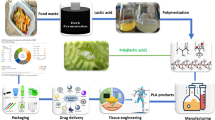Abstract
Bio-based N-substituted-2-pyrrolidone-4-carboxylic acids (PCA) are presented here as an alternative for fossil-based aromatic carboxylic acids in the synthesis of polyesters and alkyds. PCAs are synthesized by reacting itaconic acid with a primary amine, which can be monofunctional or difunctional. The bis-COOH-functional pyrrolidones, prepared from diamines, were studied in model polyester-diols using 2-butyl-2-ethyl-1,3-propanediol (BEPD) as diol and compared with several polyester-diols based on BEPD and aromatic carboxylic anhydride and acids (PA, IPA, and FDCA) and adipic acid. Monocarboxylic acid functional PCAs were studied in alkyd syntheses as alternative for benzoic acid. Coatings based on alkyd emulsions derived from cyclic amine PCAs showed an increased pendulum hardness, whereas linear PCA-nHA-based alkyd emulsion yielded a coating with a lower pendulum hardness. An alkyd emulsion with potentially 100% bio-based content was made using PCA based on aniline (PCA-AN) and succinic acid, which also resulted in a coating with improved pendulum hardness. PCA-AN was also used in the synthesis of an uralkyd (urethane alkyd) and compared with the BA-based reference. The PCA-AN-based coating showed an increased pendulum hardness. Water resistance and dark-induced yellowing of the white pigmented coatings based on PCA-AN-based alkyd emulsions were on the same level when compared to the benzoic acid containing references.




Similar content being viewed by others

References
Link: Climate Change & the Carbon Footprint - Global Footprint Network
Research towards bio-based aromatic carboxylic acids is still being carried out on lab and/or pilot scale. Most routes are based on bio-technologies. BioBTX is a start-up making BTX (benzene, toluene, xylenes, precursors for benzoic acid, terephthalic acid, phthalic anhydride) from bio-mass on pilot scale (BioBTX - Leader in Renewable and Biobased Aromatics); Origin Materials is in an upscaling phase for the production of terephthalic acid using a chemical conversion process (Origin Materials - Origin Materials)
Papageorgiou, GZ, Papgeorgiou, DG, Terzopoulou, Z, Bikiaris, NB, “Production of Bio-Based 2,5-Furan Dicarboxylate Polyesters: Recent Progress and Critical Aspects in Their Synthesis and Thermal Properties.” Eur. Polym. J., 83 202–229 (2016)
Yang, J, Xu, H, Jiang, J, Zhang, N, Xie, J, Wei, M, Zhoa, J, “Production of Itaconic Acid Through Micobiological Fermentation of Inexpensive Materials.” J. Bioresour. Bioprod., 4 (3) 135–142 (2019)
Link: Evonik launches first renewable isophorone-based products - Evonik Industries
Qi, P, Chen, H-L, Nguyen, HTH, Lin, C-C, Miller, SA, “Synthesis of biorenewable and Water-Degradable Polylactam Esters from Itaconic Acid.” Green Chem., 18 4170 (2016)
Noordzij, GJ, van den Boomen, YJG, Gilbert, C, van Elk, DJP, Roy, M, Wilsens, CHRM, Rastogi, S, “The aza-Michael Reaction: Towards Semi-Crystalline Polymers from Renewable Itaconic Acid and Diamines.” Polym. Chem., 10 4049 (2019)
Roy, M, Noordzij, GJ, van den Boomen, Y, Rastogi, S, Wilsens, CHR, “Renewable (Bis)pyrrolidone Based Monomers as Components for Thermally Curable and Enzymatically Depolymerizable 2-Oxazoline Thermoset Resins.” ACS Sustain. Chem. Eng., 5 5053 (2018)
Link alkyds: Alkyd Resins | Protective Organic Coatings | Handbooks | ASM Digital Library (asminternational.org)
Links: Mass balance method: The Mass Balance Approach > ISCC System (iscc-system.org); 14C method: EN 16640 - European Standards (en-standard.eu)
van der Boon, LJP, Klein Schiphorst, ITM, van Klink, AGML, van den Berg, KJ, “Alkyd Resin, Coating Composition, and Substrate Coated with Such a Coating Composition.” Patent WO2022194945, (2022)
% bio-based is calculated as weight% of bio-based monomers on total weight polymer. Surfactants used for emulsification are excluded from the calculation. Also potentially biobased carbons are counted taking both mass-balance and 14C method in consideration
Acknowledgments
The authors would like to thank colleagues from AkzoNobel who contributed to this work, in particular Maurits Thomson, Tom van’t Veer, Aline Silveira Serralbo, and Rene Freeke for carrying out part of the experimental work.
Author information
Authors and Affiliations
Corresponding author
Ethics declarations
Conflict of interest
The authors declare that we do not have any commercial or associative interest that represents a conflict or associative interest that represents a conflict in connection with the work submitted.
Additional information
Publisher's Note
Springer Nature remains neutral with regard to jurisdictional claims in published maps and institutional affiliations.
This paper was presented at the 18th Coatings Science International Conference held on June 26–29, 2023, in Noordwijk, the Netherlands.
Rights and permissions
Springer Nature or its licensor (e.g. a society or other partner) holds exclusive rights to this article under a publishing agreement with the author(s) or other rightsholder(s); author self-archiving of the accepted manuscript version of this article is solely governed by the terms of such publishing agreement and applicable law.
About this article
Cite this article
van den Berg, K.J., van der Boon, L.J.P., van Klink, A.G.M.L. et al. Use of N-substituted-2-pyrrolidone-4-carboxylic acids as bio-based monomers for alkyd syntheses: route to 100% bio-based alkyd emulsions. J Coat Technol Res (2024). https://doi.org/10.1007/s11998-023-00872-6
Received:
Revised:
Accepted:
Published:
DOI: https://doi.org/10.1007/s11998-023-00872-6



